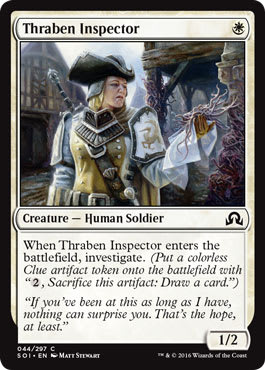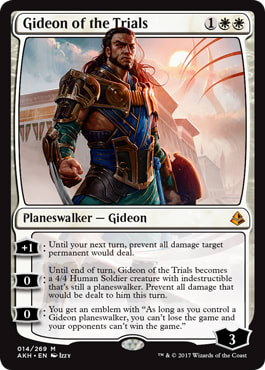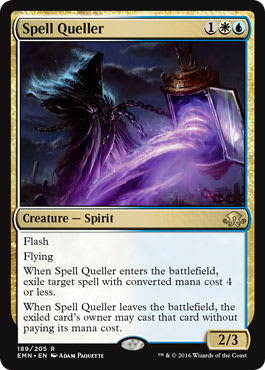Ixalan spoilers are already out but there is still a ton of Hour of Devastation Standard to play! This Standard is great! Whether you’re gearing up for the next Grand Prix, the traveling circus hitting town, or (probably like me) just the joy of your third round enemy’s blood dripping down the corner of your mouth at Friday Night Magic, I encourage you to play as much of this Standard as you can.
I won three consecutive FNMs last month, the most recent of which was with Roman Fusco’s physical Approach of the Second Sun deck from his archetype-making Classic Top 8. As good as the deck was to start, time, testing, and tournament trials taught us better and better ways to approach Approach.
This is the version of ![]()
![]() Approach of the Second Sun that we would currently recommend:
Approach of the Second Sun that we would currently recommend:
W/U Approach ? Hour of Devastation Standard | @yayitsmichaelj + @romanfusco
- Creatures (2)
- 2 Thraben Inspector
- Instants (22)
- 2 Consign // Oblivion
- 4 Blessed Alliance
- 4 Censor
- 4 Glimmer of Genius
- 4 Hieroglyphic Illumination
- 4 Supreme Will
- Sorceries (7)
- 3 Approach of the Second Sun
- 4 Fumigate
- Enchantments (4)
- 4 Cast Out
- Lands (25)
- 5 Plains
- 9 Island
- 1 Aether Hub
- 2 Ipnu Rivulet
- 4 Irrigated Farmland
- 4 Prairie Stream
- Sideboard (15)
- 4 Authority of the Consuls
- 2 Linvala the Preserver
- 1 Negate
- 2 Regal Caracal
- 4 Spell Queller
- 1 Sphinx of the Final Word
- 1 Summary Dismissal
The changes to the main deck may seem minor, but they represent not just a substantial variation in your game play . . . But in how the opponent has to play against you.
MAIN DECK
+1 Cast Out
As we noted repeatedly in the previous discussion of ![]()
![]() Approach of the Second Suns, Aether Meltdown is at least arguably the weakest card in the starting sixty. It has some utility against Mardu Vehicles, and is no slouch in the Mono-Red matchup, but it is a serious non-bo with Blessed Alliance.
Approach of the Second Suns, Aether Meltdown is at least arguably the weakest card in the starting sixty. It has some utility against Mardu Vehicles, and is no slouch in the Mono-Red matchup, but it is a serious non-bo with Blessed Alliance.
Casting an Aether Meltdown on an early attacker can actually provide your opponent cover for a future Blessed Alliance, neutralizing your next removal spell! Barf :(
In addition to removing the pesky non-bo from the ![]()
![]() main, these specific changes make three improvements to the deck, irrespective of matchup:
main, these specific changes make three improvements to the deck, irrespective of matchup:
1) First, they reduce the effective casting cost of the deck, swapping out four twos for (at least potentially) four ones. Practically and ultimately, none of the ones is “really” a one; Thraben Inspector is kind of a three, and both Cast Out and Hieroglyphic Illumination function even better as fours. But they are all ones if you need them to be, especially early on or when your resources are constrained.
2) All four cards increase the consistency of the deck. Unlike Aether Meltdown, Thraben Inspector, Hieroglyphic Illumination, and Cast Out all have text in every matchup. The original enchantment, by contrast, has no effective text in, say, the mirror. This both decreases the volatility of opening hands and improves your mulligan frequency.
3) All four cards improve the quality of your draws long term. Adding two 1 mana cantrips to this deck effectively increases its land count, Xerox-style, without actually having to add a 26th land. Thraben Inspector might eat a Shock and draw an extra card later (which is not even worse, necessarily, than Aether Meltdown), and drawing an extra card against blue will just get you to seven or ten or thirteen faster than you would have with a flash-y enchantment alternative.
Thraben Inspector is certainly a downgrade for specifically defense, but not that much of one. The ability to deter an opposing 2/1 or outright eat a 1/1 can be better than Aether Meltdown without leaving you open to the Blessed Alliance non-bo. With only two copies of Thraben Inspector, it is unlikely you will ever actually kill someone with damage Game 1, but not impossible. It can certainly help out in sideboarded fights.
On balance, Thraben Inspector can create a target for Unlicensed Disintegration or other point removal where there previously were none main deck. That said, it is almost infinitely better in the mirror (which is a more common matchup than Mardu). Besides putting the opponent under a non-zero amount of pressure, Thraben Inspector can help you hit 7+ lands in play without sacrificing what might be an important Supreme Will later.
Subtly, and beyond “just” being card advantage (which is great in itself), Thraben Inspector gives you a very specific additional dimension in sideboarded game. More on that in a minute.
-2 Unsummon
This change is a strict downgrade from the perspective of a pure Unsummon, as Consign is simply twice the cost. But Standard demands some interactions a pure Unsummon just can’t muster.
You can still do all of the stuff that Unsummon did. You know, bouncing creatures at instant speed and all that. With Thraben Inspector, this even becomes a card drawing card! You get a cute interaction with Chandra, Flamecaller that would make for an interesting story at almost any dimly-lit public house. However there is an even more important wrinkle to this change, and one well worth the downgrade in pure mana efficiency:
Gideon of the Trials is this deck’s mortal enemy. It is super hard to deal with, especially when the opponent is on the play. The reason is, in Game 1, the opponent can go straight to Gideon emblem, which makes winning next to impossible.
You can cast five hundred copies of Approach of the Second Sun and it won’t matter if Gideon and his emblem are both on the battlefield at the same time.
The previous version of this archetype had only three copies of Cast Out to interact with a resolved Gideon. Consign effectively doubles your ways of beating this interaction (now six cards, given the fourth Cast Out). It is also slightly more consistent than Cast Out. For instance, if you Cast Out the Gideon the opponent can Cast Out (or otherwise remove) your Cast Out before Approach of the Second Sun resolves, returning Gideon to play and saving himself. If you instead bounce Gideon to his hand at the end of his turn, the opponent loses this ability to stop you from winning in response to the Approach.
And then there is Oblivion!
We did a little something cute to be able to cast the Oblivion side. It obviously doesn’t come up every game, but the added capability of Rotting the opponent’s Mind can help in a variety of matchups. It can tear the Approach of the Second Sun out of the permission-poor mirror’s hand; it punishes non-renewable damage sources like Incendiary Flow; and it’s always pure card advantage coming, as it does, from the graveyard rather than grip.
MANA BASE
+2 Ipnu Rivulet
We talked about this last time. Ipnu Rivulet is better in almost every way, if not in every imaginable situation. Your most common target will be yourself, where you get two cards closer to the re-buy on a second Approach (the same as the most common functionality for Blighted Cataract). The difference is in mana, where Ipnu Rivulet frees up a ton of mana, allowing you to protect yourself better than the land hungry Blighted Cataract during the last turns of the game.
Which is not to say that you won't deck the odd Izzet deck, because Ipnu Rivulet certainly helps there.
A not insignificant upgrade is that Ipnu Rivulet, unlike Blighted Cataract, taps for blue mana in addition to colorless, improving some opening hands including Censor.
-1 Plains
+1 Aether Hub
Aether Hub is a card I borrowed from Gabriel Nassif’s version of ![]()
![]() :
:
Best deck in Standard, easy 5-0: pic.twitter.com/NTCG1fBXEW
— gabriel nassif (@gabnassif) August 7, 2017
It fixes your mana, kind of, and in some games, gives you the black you need to cast the back side of Consign // Oblivion! Cool, right? Less experienced opponents may never see this coming, and waltz straight into your back alley black Aftermath.
Small tactical note: Aether Hub comes into the battlefield with one energy, which you might actually have to use for white or blue mana near-term. Past incarnations of this deck didn't have to pay attention to their energy counts, but this version should actually bookkeep every Glimmer of Genius, even with only one sink. Though you’ll not likely need to tap for black more than twice.
SIDEBOARD
The main difference between this sideboard and the previously suggested versions is the addition of Spell Queller. Spell Queller serves a double purpose here: redundancy over previous slots devoted to cards like Negate or Summary Dismissal and the addition of a relatively cheap and mana efficient clock.
In particular Spell Queller is useful in the mirror match; or, I suppose, any deck that taps for random card drawing spells like Supreme Will or Glimmer of Genius. Basically, the opponent taps out and you Spell Queller them. Now you’ve put them on a ten-turn clock.
The synergy here is Spell Queller and Thraben Inspector. An opposing ![]()
![]() deck can’t really sideboard out all of its removal cards, so the opponent might still have Blessed Alliance. Thraben Inspector is an absolute All-Star! Attack with Thraben Inspector and Spell Queller at the same time and the Inspector will defend the Spell Queller from Blessed Alliance! It’s kinda sorta the opposite of the Aether Meltdown it replaced. This, of course, is in addition to drawing an extra card (which is also great in a mirror).
deck can’t really sideboard out all of its removal cards, so the opponent might still have Blessed Alliance. Thraben Inspector is an absolute All-Star! Attack with Thraben Inspector and Spell Queller at the same time and the Inspector will defend the Spell Queller from Blessed Alliance! It’s kinda sorta the opposite of the Aether Meltdown it replaced. This, of course, is in addition to drawing an extra card (which is also great in a mirror).
Finally, Sphinx of the Final Word is there to ensure that your Approach of the Second Sun will always resolve, against another deck that can tap an island interactively.
The one card I feel like I’m missing is Torrential Gearhulk. With so many Dissenters Deliverences and main-deck Abrades floating around though, Torrential Gearhulk may be at the low point of its relatively short (if indubitably outstanding) career.
Draw cards. Take names.
LOVE
MIKE

























